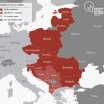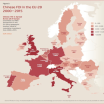It all began in April 2012, when Chinese Premier of the State Council Wen Jiabao met for the first time with the leaders of 16 Central and Eastern European countries (CEE). Among them, eleven are current members of the European Union (Estonia, Latvia, Lithuania, Poland, Czech Republic, Slovakia, Hungary, Slovenia, Croatia, Romania and Bulgaria), while the other five (Albania, Bosnia-Herzegovina, Macedonia, Montenegro and Serbia) are still outside the EU. This dialogue is based on five main fields: investments, transport, finance, science, education and culture. Thus allowing China to pursue its priorities such as the construction of infrastructures and the development of high-tech and eco-friendly technologies as well as to justify its presence in the region.
What drives China’s interest in the CEE countries?
Through the analysis of the Chinese international interests and ambitions, what emerges is a clear picture of the role played by the CEE countries both from a political and economic perspective. The key word to understand China’s priorities is “OBOR”. The One Belt One Road is a huge project developed by Chinese President Xi Jinping, who aims at connecting the Eurasian continent through massive investment and development of trade routes in the region. In fact, as affirmed by Kevin Sneade (McKinsey’s Chairman in Asia), OBOR has the potential to affect “about 65% of the world’s population, about one third of the world’s GDP and about a quarter of all the goods and services the world moves” . Interestingly, this project is supposed to include all these 16 countries in its routes, thus linking the investments made by China in Central and Eastern European countries with the long-term objective of developing suitable infrastructures essential for OBOR. Thus, China’s One Belt One Road has been compared to two historical events: the People’s Republic of China’s second opening and the Marshall Plan adopted by the US after WWII.
Economic perspective: China’s impact in the region
It is undeniable that this cooperation is a source of an incredible development in China-CEE economic relations. Trade in 2015 has reached $56.2 billion (+28% compared to 2010), in addition to the exceeding $5 billion invested by China in the 16 CEE countries and a total amount of US$ 1.6 billion invested by these same countries in China . In five years up to 2014, China’s ODI to CEE countries grew by nearly 100%, from 853 million to $1,7 billion, the two thirds of which was directed to three countries: Hungary, Poland and Czech Republic . Since 2014, China’s economic impact in the region has steadily grown, peaking in the setting up of a €10 billion investment fund to finance projects, finally approved last November in occasion of the fifth “16+1 summit” which was held in Riga, Latvia.
Practically speaking, there’s plenty of major transport and energy infrastructure projects financed with Chinese loans: from €156 million to Montenegro for the renewal of the country’s ship fleet, to the impressive €1.5 billion investment for the Belgrade-Budapest high speed railway, passing by the creation of a thermal and hydro power plants in Romania which require a total amount of €2 billion.
Political issues: European concerns
If at the economic level, the “16+1” initiative might appear as a win-win cooperation, the reality is more complicated. In fact, a constant feature of any relation involving China is the suspicion felt by its partners of hidden strategic interests that the Chinese Communist Party (CCP) might pursue.
At the European Union level, two main concerns emerge:
1. The “16+1” initiative as a pro-China lobby within the EU: is China’s “divide and rule” strategy aiming at weakening the EU as a unified power? The European institutions, supported by some prominent EU actors such as Germany, have been involved in debates where China is accused of attempting to divide the EU to facilitate the development of a pro-China lobby within the European framework. The China-CEE cooperation might thus result in weakening the appeal of EU institutions by creating a group of states carrying a different attitude to China from the one officially represented in Brussels.
2. Will the “16+1” platform represent an alternative to the official China-EU relations?
China’s interests represent a threat also in terms of political and diplomatic relations with the European Union. In fact, a popular perspective on the issue presents the CCP as more interested in fostering bilateral relations with the European countries to maximise China’s outcomes, even at the cost of weakening China-EU official relations.
What is the next step for the EU?
What emerges is that the European Union seems to be following a wrong approach. On the one hand, the “16+1” initiative is mostly still unknown even among the main actors of the EU institutions, thus ignoring its future potential. On the other side, when the EU engages in a debate on this issue, the conclusions exaggerate the reality. In fact, despite the legitimate concerns of an increasing Chinese influence, the EU should be mindful of the fact that Chinese main foreign investments are still headed to the UK, Italy, France and Germany, clearly overtaking Chinese economic impact in CEE countries. In addition, the immense diversification of the Central and Eastern European States make it extremely difficult to find common ground for a united approach, thus making it highly unlikely to represent a reliable alternative to Brussels in China’s eyes. The European Union should therefore take in higher consideration the “16+1” initiative, with the option of officially supporting and institutionalising it in the EU-China Partnership, which since 2003 represents the official basis of its relations with China.
Sources
1) http://www.ecfr.eu/page/-/China_Analysis_Sixteen_Plus_One.pdf
2) http://www.mckinsey.com/global-themes/china/chinas-one-belt-one-road-will-it-reshape-global-trade
3) http://www.europarl.europa.eu/RegData/etudes/BRIE/2016/586608/EPRS_BRI(2016)586608_EN.pdf
4) http://www.chinadaily.com.cn/world/2016liattendsSCOCCEEC/2016-11/07/content_27301134.htm



Follow the comments: |
|
